With the end of 2019 upon us, the holiday season is a great time to take a look back at the most influential patents—rather than patent stories, which we will be publishing in a few days—representing a variety of important developments from this year. As we explore some of the patents and technologies that have had the greatest impact on the previous year, our focus will be upon both patents that have led to court decisions having major ramifications on the U.S. patent system, as well as those patents representing major advances in technological sectors that are growing more important by the day. From Athena v. Mayo to brainwave device authentication methods, 2019 offered no shortage of impressive innovations and depressing patent-eligibility decisions.
Athena Diagnostics’ Method for Diagnosing Neurotransmission Disorders
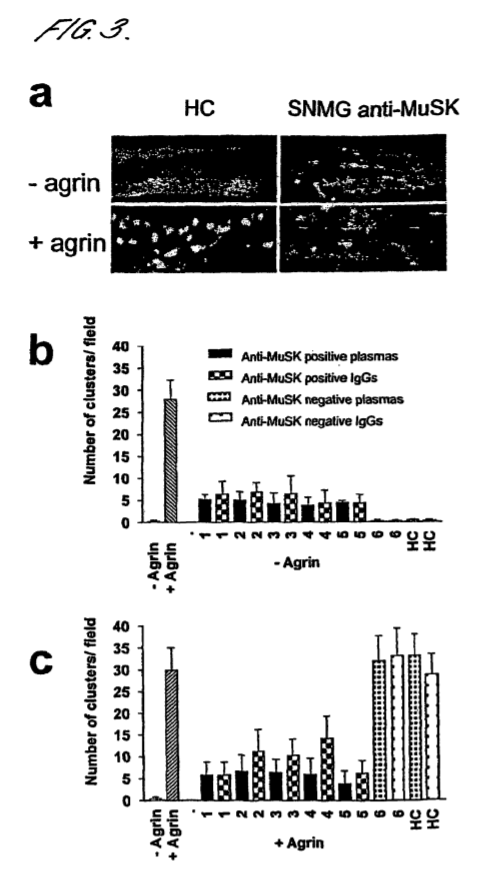 In September 2007, the U.S. Patent and Trademark Office issued U.S. Patent No. 7267820, Neurotransmission Disorders, to Isis Innovation Limited of England and the Max Planck Society of Germany. It claims a method for diagnosing neurotransmission or developmental disorders related to muscle specific tyrosine kinase (MuSK) in a mammal by contacting the mammal’s bodily fluid with MuSK or a MuSK antigenic determinant, and detecting any antibody-antigen complexes formed in the bodily fluid which is indicative of neurotransmission or developmental disorders which are being suffered by that mammal.
In September 2007, the U.S. Patent and Trademark Office issued U.S. Patent No. 7267820, Neurotransmission Disorders, to Isis Innovation Limited of England and the Max Planck Society of Germany. It claims a method for diagnosing neurotransmission or developmental disorders related to muscle specific tyrosine kinase (MuSK) in a mammal by contacting the mammal’s bodily fluid with MuSK or a MuSK antigenic determinant, and detecting any antibody-antigen complexes formed in the bodily fluid which is indicative of neurotransmission or developmental disorders which are being suffered by that mammal.
The patent covers a novel method for diagnosing myasthenia gravis (MG), a chronic autoimmune disorder causing muscle weakness symptoms such as fatigue, drooping eyelids or double vision. In 1960, scientific researchers discovered that MG was an autoimmune disorder caused by antibodies inhibiting the activity of the acetyl choline receptor (AChR). While prior diagnostic methods were capable of diagnosing 80 percent of MG patients by detecting AChR autoantibodies in the patient’s plasma, the invention covered by the ‘820 patent is capable of diagnosing the 20 percent of MG patients who don’t exhibit AChR autoantibodies.
This is, of course, the patent at the middle of the Athena Diagnostics/Mayo Collaborative Services legal battle which reached a fever pitch this summer at the U.S. Court of Appeals for the Federal Circuit. In early July, the Federal Circuit entered a highly splintered decision to deny an en banc rehearing of Athena v. Mayo and many in the patent world hope that this case is taken up on appeal to the U.S. Supreme Court in order to see some sanity return to Section 101 patent eligibility under the Alice/Mayo framework.
Solutran’s Paper Check Processing System
In January 2007, the USPTO issued U.S. Patent No. 8311945, System and Method for Processing Checks and Check Transaction, to Minneapolis-based financial technology firm Solutran. It claims a method for processing paper checks by electronically receiving a file of data captured at a merchant’s point of purchase including magnetic ink character recognition (MICR) information for each check, the information being associated with a transaction amount. Once the data file is received, the method follows by crediting a merchant account, receiving paper checks and scanning them to create check images that are associated with the check’s MICR, and then comparing the digital check images with data from the data file to find matches.
 For most of the history of paper checks, physical processing methods required physical transport and information recording techniques were often prone to human error. While electronic processing of check transactions facilitated by the Automated Clearing House (ACH) Network has helped to address some of these issues, a need for paper checks remained to serve as evidence that a transaction was authorized or that the check has been forged. The invention in the ‘945 patent enables prompt transaction processing through a third party payment processor, providing for improved funds availability to merchants while also storing check images and providing for check destruction in accordance with federal regulations.
For most of the history of paper checks, physical processing methods required physical transport and information recording techniques were often prone to human error. While electronic processing of check transactions facilitated by the Automated Clearing House (ACH) Network has helped to address some of these issues, a need for paper checks remained to serve as evidence that a transaction was authorized or that the check has been forged. The invention in the ‘945 patent enables prompt transaction processing through a third party payment processor, providing for improved funds availability to merchants while also storing check images and providing for check destruction in accordance with federal regulations.
Like Athena’s diagnostic method patent, Solutran’s physical check processing patent gained notoriety this year when the Federal Circuit issued a decision this July in Solutran v. Elavon which invalidated the asserted claims of the ‘945 patent. In a decision emblematic of the uncertainty caused by Section 101 jurisprudence, the Federal Circuit found that the recitation of physical elements, including paper checks, within the claims didn’t prevent those claims from invalidation for being directed to an abstract idea.
ChargePoint’s Electric Vehicle Charging Network
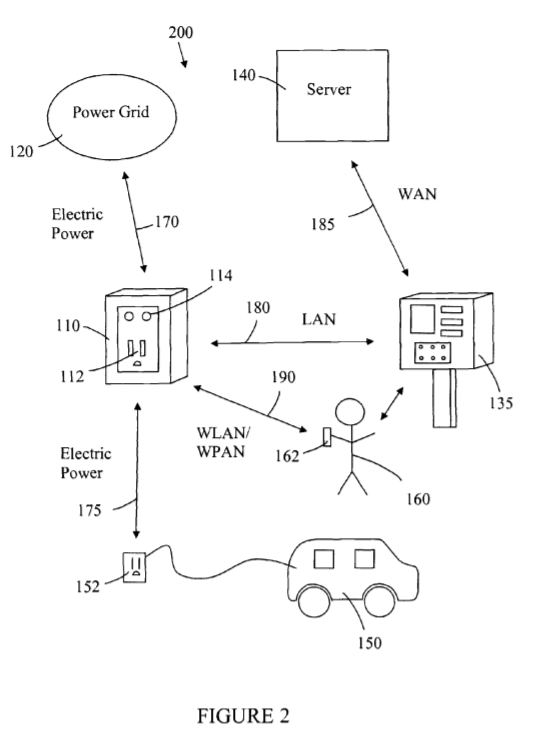 In March 2012, the USPTO issued U.S. Patent No. 8138715, Network-Controlled Charging System for Electric Vehicles Through Use of a Remote Server, to Coulomb Technologies of Campbell, CA. It claims an apparatus including a control device that enables and disables charge transfer for electric vehicles, a transceiver that communicates requests for charge transfer with a remote server, and a controller coupled with the control device and the transceiver to cause the control device to turn on an electric supply in response to communications from the remote server.
In March 2012, the USPTO issued U.S. Patent No. 8138715, Network-Controlled Charging System for Electric Vehicles Through Use of a Remote Server, to Coulomb Technologies of Campbell, CA. It claims an apparatus including a control device that enables and disables charge transfer for electric vehicles, a transceiver that communicates requests for charge transfer with a remote server, and a controller coupled with the control device and the transceiver to cause the control device to turn on an electric supply in response to communications from the remote server.
The invention covered by the ‘715 patent was designed to address a need for a communication network for electric vehicle owners which facilitates the finding of recharging facilities as well as controlling those facilities and paying for the electricity consumed. The system supported by the ‘715 patent’s technology connects electrical outlets connected by a local area network and electric vehicle operators communicating via mobile communication devices to allow those operators to pay for parking and recharging of their electric vehicles. The system achieves this outcome by integrating wide area networks, local area networks and short-range communication devices.
Like the aforementioned patents, this ‘715 patent achieved some unfortunate notoriety this year when the Federal Circuit invalidated asserted claims of the patent in deciding ChargePoint v. SemaConnect this April. In a holding that applied the Alice/Mayo Section 101 framework in a way that might have swallowed all of patent law, the Federal Circuit found that claim 1 of the ‘715 patent was directed to the abstract idea of communication over a network.
Dabus AI’s Patent Applications for Food Container and Attention Attracting System
Although the patent applications themselves remain unpublished, news reports indicate that a team of artificial intelligence (AI) researchers have filed a pair of patent applications in patent offices around the world, including the USPTO, on behalf of an AI inventor known as Device for the Autonomous Bootstrapping of Unified Sentience (Dabus). These are reportedly the world’s first patent applications which list an AI system as the sole inventor, which has pushed the USPTO to seek public comments on whether entities other than a natural person should be allowed to obtain patent protection.
One of the Dabus AI patent applications covers an improved food container, especially those suitable for packaging liquids. The wall of the food container has a fractal profile with convex and concave fractal elements that create pits and bulges on the interior and exterior walls. Advantages of the container’s fractal profile include greater inter-engagement of multiple containers reducing the need to tie containers together during shipping, increased surface area to assist in heat transfer when heating or cooling the liquid, and an improved ability to hold the container to reduce its chances of slipping when condensation forms on the container’s exterior.
The second Dabus AI patent application covers devices and methods for attracting enhanced attention, which could be a useful technology for beacons alerting others of emergency situations. Embodiments of this invention provide a method for producing a pulse train for a light-emitting diode (LED) or lamp at a frequency and fractal dimension which is highly noticeable to humans. The pulsing light is capable of quickly attracting human attention because anomalies in the light pulsations are designed such that the human brain will take greater notice of the inconsistencies in the visual stimuli.
Trading Technologies’ Ladder Tool Patent
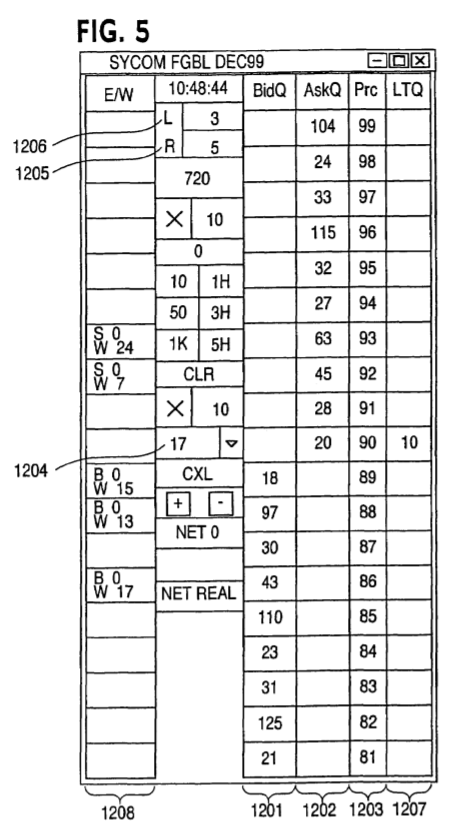 In April 2010, the USPTO issued U.S. Patent No. 7693768, Click Based Trading With Intuitive Grid Display of Market Depth, to Trading Technologies of Chicago, IL. It claims a method of placing a trade order for a commodity on an electronic exchange using a graphical user interface (GUI) and a user input device. The GUI includes a dynamic bid display region with different areas corresponding to price levels along a price axis and the dynamic display is designed to communicate any changes in price levels which are currently available on the market.
In April 2010, the USPTO issued U.S. Patent No. 7693768, Click Based Trading With Intuitive Grid Display of Market Depth, to Trading Technologies of Chicago, IL. It claims a method of placing a trade order for a commodity on an electronic exchange using a graphical user interface (GUI) and a user input device. The GUI includes a dynamic bid display region with different areas corresponding to price levels along a price axis and the dynamic display is designed to communicate any changes in price levels which are currently available on the market.
At the time of the invention, at least 60 exchanges throughout the world utilized electronic trading systems. However, constantly moving variables in trading markets often caused situations where pricing changes would occur in the time between which an order was placed and when it was executed, an issue that often resulted in significant losses for high-volume traders. The invention covered by the ‘768 patent, often referred to as the “ladder tool,” reduces the time it takes for a trader to place an order on an exchange, improving the chances that those orders will occur at desirable prices and quantities.
This year, the ‘768 patent and other Trading Technologies’ patents have been in the news since the Federal Circuit upheld covered business method (CBM) reviews by the Patent Trial and Appeal Board (PTAB) invalidating the ladder tool patent claims under Section 101 for being directed to an abstract idea. Trading Technologies has petitioned for rehearing of these decisions on the basis that the ladder tool is indistinguishable from a mechanical tool, making it patent-eligible and not subject to CBM review.
The University of California’s CRISPR-Cas9 Gene Editing Method
 In October 2019, the USPTO issued U.S. Patent No. 10428352, Methods and Compositions for RNA-Directed Target DNA Modification and for RNA-Directed Modulation of Transcription, to the University of California, the University of Vienna and German inventor Emmanuelle Charpentier. It claims a method of targeting and binding a target DNA in a prokaryotic cell by targeting the DNA with a Cas9 protein and an RNA nucleotide sequence complementary to a target DNA sequence and also having activator-RNA that hybridizes with the targeter-RNA to form a double-stranded RNA duplex.
In October 2019, the USPTO issued U.S. Patent No. 10428352, Methods and Compositions for RNA-Directed Target DNA Modification and for RNA-Directed Modulation of Transcription, to the University of California, the University of Vienna and German inventor Emmanuelle Charpentier. It claims a method of targeting and binding a target DNA in a prokaryotic cell by targeting the DNA with a Cas9 protein and an RNA nucleotide sequence complementary to a target DNA sequence and also having activator-RNA that hybridizes with the targeter-RNA to form a double-stranded RNA duplex.
About 60 percent of bacteria and 90 percent of archaea single-celled contain clustered regularly interspaced short palindromic repeats (CRISPR) segments. The invention covered by the ‘352 patent enables the targeting of DNA segments for targeted gene deletion, replacement and repair accomplished by Cas9 proteins that can cut targeted CRISPR segments from DNA sequences. The ‘352 patent is one of the most recent issued to the University of California covering its CRISPR-Cas9 gene editing technologies which have been the focus of an ongoing patent feud with the Broad Institute, the Massachusetts Institute of Technology and Harvard College.
IBM’s Brain Signal Device Authentication System
In November 2019, the USPTO issued U.S. Patent No. 10482227, Electroencephalography (EEG) Based Authentication, to IBM of Armonk, NY. It claims a computer-implemented authentication method by decoding brain activity into a brain pattern sequence as an entry for password into a locked device, applying brain dialogue to interact with a user while the user is entering the brain pattern sequence, matching the brain pattern sequence with a predetermined password to allow access to a system, and embedding an alarm module that activates when the user is under a threat as determined by a brain pattern sequence.
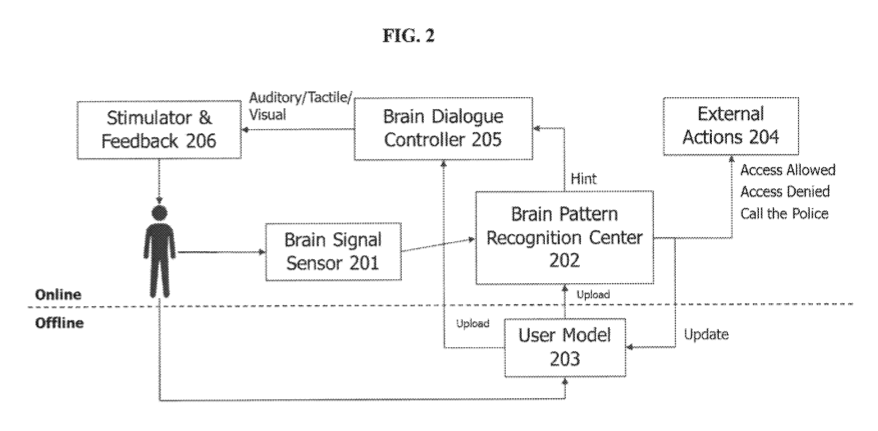
The invention covered by the ‘227 patent relates to a biometric authentication method similar to fingerprint authentication or a retina scan. However, these authentication methods can be faked to gain access to a locked device even in the event that a device owner dies, creating a need to utilize human brain signals for device authentication. This invention is characteristic of the wide array of innovation that results from the research and development activities of IBM, which has received the greatest number of issued U.S. patents among any patent-filing entity for 26 straight years.
Nokia’s Quality of Service and Experience Methods for 5G OTT Applications
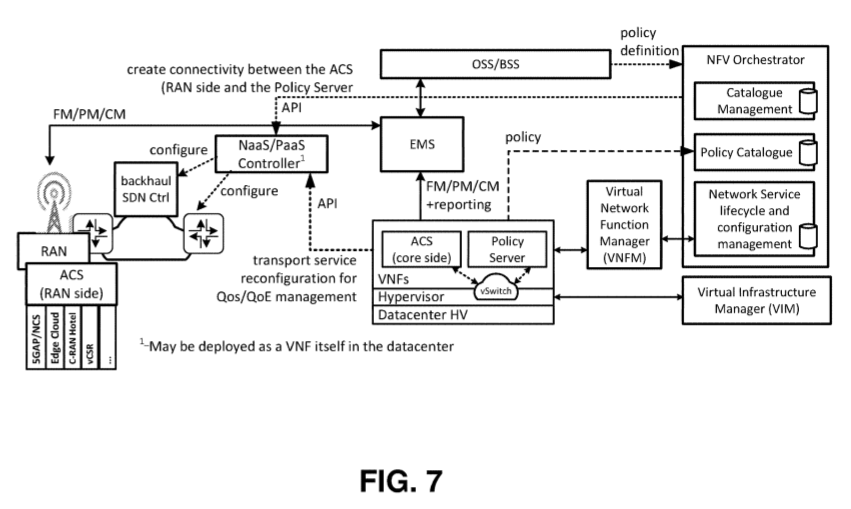 In March 2019, the USPTO issued U.S. Patent No. 10243860, Method and Apparatus for End-to-End QoS/QoE Management in 5G Systems, to Finnish telecom firm Nokia. It claims a method for providing dynamic and adaptive quality of service (QoS) and quality of experience (QoE) traffic management while implementing user and application specific differentiation and maximizing system resource utilization. The method involves accessing QoS and QoE policies from a policy server at one or more enforcement points to provide QoE targets, autonomously and individually interpreting the QoS/QoE policies, and then applying the policies to the current network context without having to define a specific policy for each potential context.
In March 2019, the USPTO issued U.S. Patent No. 10243860, Method and Apparatus for End-to-End QoS/QoE Management in 5G Systems, to Finnish telecom firm Nokia. It claims a method for providing dynamic and adaptive quality of service (QoS) and quality of experience (QoE) traffic management while implementing user and application specific differentiation and maximizing system resource utilization. The method involves accessing QoS and QoE policies from a policy server at one or more enforcement points to provide QoE targets, autonomously and individually interpreting the QoS/QoE policies, and then applying the policies to the current network context without having to define a specific policy for each potential context.
The invention covered by the ‘860 patent provides dynamic end-to-end QoS/QoE management architecture for 5G networks to maximize customer experience and system resource utilization while providing efficient congestion management. The techniques are designed to improve traffic management by meeting critical QoS requirements for various over-the-top (OTT) applications for web browsing, video streaming, navigation, social media, real-time voice/video and various other functions that are expected to attract even higher levels of network traffic with the advent of 5G networks. As of this July, Nokia only trailed Chinese telecom firm Huawei in terms of declared patent families related to 5G networks.
Bell Helicopter Textron’s Blockchain Technology for Airspace Management
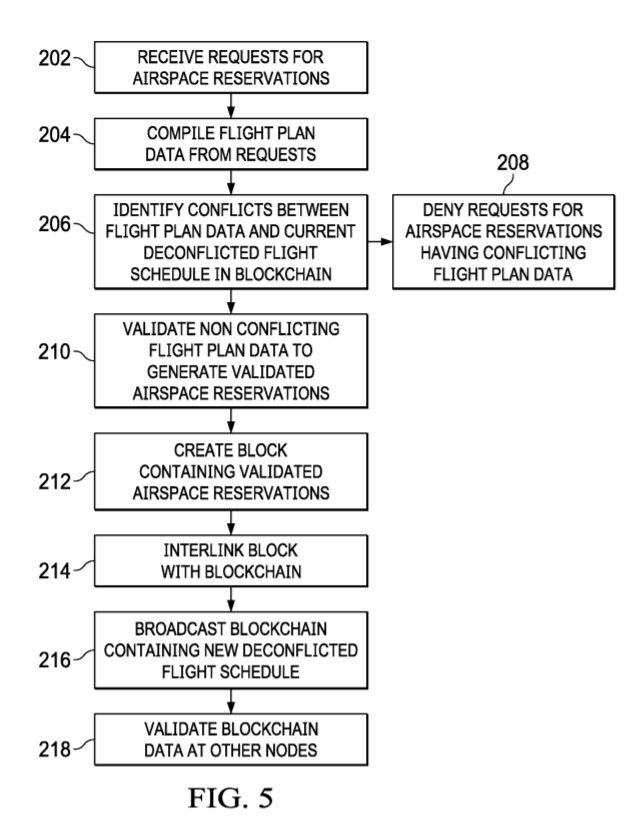 In December 2019, the USPTO issued U.S. Patent No. 10497267, Blockchain Airspace Management for Air Taxi Services, to Bell Helicopter Textron of Fort Worth, TX. It claims a system for airspace management within an airspace region where the system operates within a peer-to-peer network having a plurality of nodes. The system includes a blockchain containing a current deconflicted flight schedule for the airspace region where each node has a processor, coupled to a storage unit, executing code to enable the node to receive requests for airspace reservations including flight plan data, compile that data to identify conflicts in airspace reservation requests and the deconflicted flight schedule, validate the flight plan with the deconflicted flight schedule, create a block containing the validated airspace reservations, and interlink the block with the blockchain to broadcast to other nodes the deconflicted flight schedule for the airspace region.
In December 2019, the USPTO issued U.S. Patent No. 10497267, Blockchain Airspace Management for Air Taxi Services, to Bell Helicopter Textron of Fort Worth, TX. It claims a system for airspace management within an airspace region where the system operates within a peer-to-peer network having a plurality of nodes. The system includes a blockchain containing a current deconflicted flight schedule for the airspace region where each node has a processor, coupled to a storage unit, executing code to enable the node to receive requests for airspace reservations including flight plan data, compile that data to identify conflicts in airspace reservation requests and the deconflicted flight schedule, validate the flight plan with the deconflicted flight schedule, create a block containing the validated airspace reservations, and interlink the block with the blockchain to broadcast to other nodes the deconflicted flight schedule for the airspace region.
While cryptocurrency has garnered the most media attention among blockchain technologies, distributed ledgers are applicable to an incredibly wide number of industries as is evidenced by the ‘267 patent. The technology protected by this patent uses blockchain to improve upon conventional air traffic control systems that typically use visual observation as the primary method of controlling airspace in an immediate airport environment. The invention addresses issues related to increased air traffic caused by new forms of aircraft transportation as well as the potential for human error leading to single point of failure in airspace provisioning.
U.S. Health and Human Services’ Process for Inhibiting HIV Infection
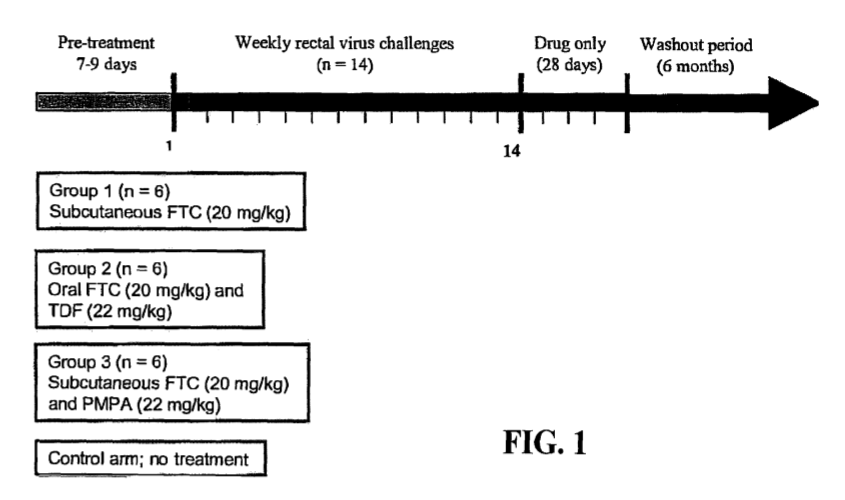 This July, the USPTO issued U.S. Patent No. 10335423, Inhibition of HIV Infection Through Chemoprophylaxis, to the U.S. Department of Health and Human Services (HHS). It claims a process of protecting a primate host from a self-replicating infection by an immunodeficiency retrovirus. The process involves selecting a primate host that’s not infected by the immunodeficiency retrovirus and orally administering to that primate host a combination of pharmaceutically effective amounts of emtricitabine and either tenofovir or a tenofovir prodrug where the administration happens prior to exposure to the immunodeficiency retrovirus.
This July, the USPTO issued U.S. Patent No. 10335423, Inhibition of HIV Infection Through Chemoprophylaxis, to the U.S. Department of Health and Human Services (HHS). It claims a process of protecting a primate host from a self-replicating infection by an immunodeficiency retrovirus. The process involves selecting a primate host that’s not infected by the immunodeficiency retrovirus and orally administering to that primate host a combination of pharmaceutically effective amounts of emtricitabine and either tenofovir or a tenofovir prodrug where the administration happens prior to exposure to the immunodeficiency retrovirus.
While significant progress has been made in reducing the symptoms of AIDS which is caused by contracting HIV, no vaccine has been created which provides adequate protection against the immunodeficiency retrovirus. The invention provides a pre-exposure prophylactic (PrEP) treatment which blocks the establishment of self-replicating retrovirals to avoid the contraction of HIV following exposure to the virus. The ‘423 patent is one of four patents that have recently been asserted by HHS against Gilead Sciences in a brewing legal battle involving Gilead’s PrEP treatments for HIV prevention, which policymakers and activists alike have been targeting this year because of high list prices for Truvada and Descovy.

![[IPWatchdog Logo]](https://ipwatchdog.com/wp-content/themes/IPWatchdog%20-%202023/assets/images/temp/logo-small@2x.png)

![[[Advertisement]]](https://ipwatchdog.com/wp-content/uploads/2023/01/2021-Patent-Practice-on-Demand-1.png)
![[Advertisement]](https://ipwatchdog.com/wp-content/uploads/2024/04/UnitedLex-May-2-2024-sidebar-700x500-1.jpg)
![[Advertisement]](https://ipwatchdog.com/wp-content/uploads/2024/04/Artificial-Intelligence-2024-REPLAY-sidebar-700x500-corrected.jpg)
![[Advertisement]](https://ipwatchdog.com/wp-content/uploads/2024/04/Patent-Litigation-Masters-2024-sidebar-700x500-1.jpg)

![[Advertisement]](https://ipwatchdog.com/wp-content/uploads/2021/12/WEBINAR-336-x-280-px.png)
![[Advertisement]](https://ipwatchdog.com/wp-content/uploads/2021/12/2021-Patent-Practice-on-Demand-recorded-Feb-2021-336-x-280.jpg)
![[Advertisement]](https://ipwatchdog.com/wp-content/uploads/2021/12/Ad-4-The-Invent-Patent-System™.png)






Join the Discussion
One comment so far.
Christopher Stokely, Ph.D.
December 29, 2019 01:13 amI greatly appreciate this article. I cannot imagine the tension a patent examiner experiences when reviewing a patent application, especially considering the stakes as well as the significant time constraints.
This article is very well written. It is a rarity to encounter a news article that is so thought provoking and well researched. Thank you for your efforts…
Sincerely,
Chris Stokely
Scientist and Inventor